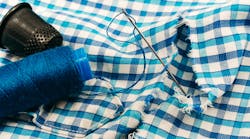Self-healing clothes may become a reality thanks to fungi
Few events are as disheartening as noticing a hole in your favorite t-shirt. Maybe you’ll keep wearing it, convincing yourself that it’s not noticeable or trying to hide it beneath a well-positioned jacket. Maybe you’ll relegate the garment to in-home wear only, pretending that the hole adds character and authenticity to the shirt. But we all know what is coming. With each washing, your t-shirt is slowly evolving from beloved attire to trusty rag. This seemingly inevitable fate didn’t have to happen. Researchers are developing materials that can heal themselves thanks in no small part to fungi.
Researchers from Newcastle University and Northumbria University in the U.K. are pushing the envelop of sustainable fashion by utilizing the threads produced by fungi to create wearable fabric. According to Science Alert, the researchers concentrated their efforts on the Ganoderma lucidum fungus. The team was able to create “a skin from branching filaments known as hyphae, which together weave into a structure called a mycelium.” The team proposes that this skin could be used as an alternative leather, although additional research is needed to know if this process can be scaled for mass production.
Mycelium-based materials, however, are not new. They are currently being utilized in several industries, but due to production processes, they lack the ability to regenerate. According to Interesting Engineering, the research team is working on a new manufacturing method that would be a mix of mycelia, chlamydospores, carbohydrates, proteins, and other nutrients in a liquid that would allow for regeneration of the skin.
The team, which includes Elise Elsacker, Meng Zhang and Martyn Dade-Robertson, recently published a study titled “Fungal Engineered Living Materials: The Viability of Pure Mycelium Materials with Self-Healing Functionalities.” In an excerpt from the paper, the researchers write: “In this study, pure mycelium materials are fabricated for use as leather substitutes, and it is found that chlamydospores, thick-walled vegetative cells formed at the hyphal tip, may be the key to the material's self-healing properties. The results suggest that mycelium materials can survive in dry and oligotrophic environments, and self-healing is possible with minimal intervention after a two-day recovery period.”
